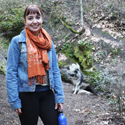Digging Jacksonville – March 2015
The Booker House was built in 1880 and is a contributing resource to Jacksonville’s National Historic Landmark District. The house is currently owned by long-time Jacksonville resident Carol Knapp, who contacted Southern Oregon University Laboratory of Anthropology (SOULA) in 2009 in preparation for renovations to her historic home. Carol worked in conjunction with SOULA archaeologists throughout the construction process, and donated the large artifact assemblage so that it could be studied.
Over the past several years, Carol has continued to be a careful steward of her archaeological site, and recorded the location of the more than 1,000 items now stored at the SOULA lab. Of these, two have been selected for this article: one is a complete Bromo-Seltzer bottle, and the other is a container of Dr. B.S. Hunt’s Domestic Corn Cure, with some of the original contents intact. These artifacts were chosen to highlight the medicinal practices of the time, as well as some of the consumer practices and types of ailments.
Bromo-Seltzer bottles are relatively common in 19th and 20th century archaeology sites across the nation. Bromo-Seltzer has been manufactured by the Emerson Drug Company of Baltimore, Maryland since the late 1800s. Sodium bromide is the main ingredient, and it is to be dissolved in water in the appropriate dosage, creating a sort of seltzer; hence the name Bromo-Seltzer. It was historically marketed as a cure for headaches, stomachaches, and even hangovers. This particular artifact is a mouth-blown, dark blue cobalt glass bottle. The mouth-blown bottles were manufactured between 1890 and 1911. Bromo-Seltzer was a popular consumer home remedy, due in-part to its incredibly-effective marketing. In fact, Bromo-Seltzer is still available today, though not widely. It is now marketed as an antacid and is no longer sold in the cobalt blue bottles.
Dr. B.S. Hunt’s Corn Treatment originated in Tawawa, Ohio, with a laboratory in Sidney, Ohio. This particular artifact was found in the attic of the Booker House in well-preserved condition. Inside the wooden container is a small corked vial made of colorless glass with the word “DOMESTIC” imprinted upon the side, and “129” on the base, which holds the remnants of the corn treatment. On the wooden container are the directions for use of the corn treatment, indicating that with use new, softer skin may start to form within one week with use of the product.
Both of these artifacts indicate the availability of consumer goods for medicinal purposes and home treatment of mild ailments. Successful marketing enabled the spread of consumer goods across the country throughout the 19th and 20th centuries. Although Jacksonville was relatively isolated from large commercial centers, residents were still participating in the wider consumer trends seen across America. On a more personal level, the presence of these artifacts indicates that a member of a family who lived in the house may have had a headache or sore foot, and sought treatment with one of these remedies. Through artifacts like these, archaeology allows us to not only to learn about the past in general, but also connect with specific individuals living in early 20th century Jacksonville.
This project was made possible with funding from Carol Knapp.
Featured image above is of from left: Cobalt blue Bromo-Seltzer bottle, and a Dr. B. Hunt’s Corn Treatment bottle and wooden case.

 Sarah Lind is a senior at Southern Oregon University majoring in anthropology. Her emphasis is archaeology, and through SOULA she has been able to become involved and engaged with local historical archaeology. Sarah has been researching the Booker House for her senior thesis the past two years, working closely with Carol Knapp to analyze and preserve the Booker House collection. You can reach SOULA by contacting Chelsea Rose at rosec@sou.edu and follow
Sarah Lind is a senior at Southern Oregon University majoring in anthropology. Her emphasis is archaeology, and through SOULA she has been able to become involved and engaged with local historical archaeology. Sarah has been researching the Booker House for her senior thesis the past two years, working closely with Carol Knapp to analyze and preserve the Booker House collection. You can reach SOULA by contacting Chelsea Rose at rosec@sou.edu and follow